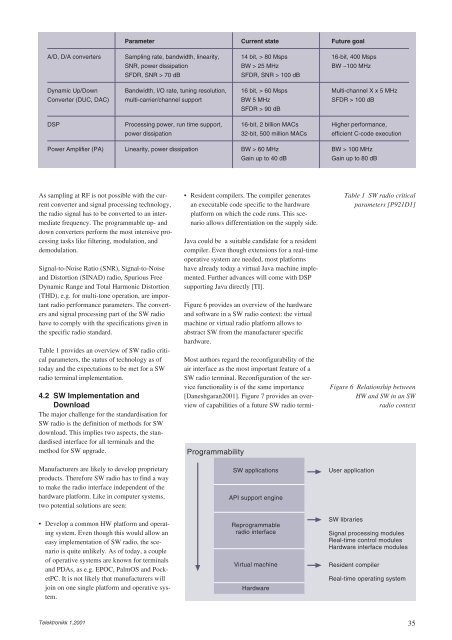Create successful ePaper yourself
Turn your PDF publications into a flip-book with our unique Google optimized e-Paper software.
As sampling at RF is not possible with the current<br />
converter and signal processing technology,<br />
the radio signal has to be converted to an intermediate<br />
frequency. The programmable up- and<br />
down converters perform the most intensive processing<br />
tasks like filtering, modulation, and<br />
demodulation.<br />
Signal-to-Noise Ratio (SNR), Signal-to-Noise<br />
and Distortion (SINAD) radio, Spurious Free<br />
Dynamic Range and Total Harmonic Distortion<br />
(THD), e.g. for multi-tone operation, are important<br />
radio performance parameters. The converters<br />
and signal processing part of the SW radio<br />
have to comply with the specifications given in<br />
the specific radio standard.<br />
Table 1 provides an overview of SW radio critical<br />
parameters, the status of technology as of<br />
today and the expectations to be met for a SW<br />
radio terminal implementation.<br />
4.2 SW Implementation and<br />
Download<br />
The major challenge for the standardisation for<br />
SW radio is the definition of methods for SW<br />
download. This implies two aspects, the standardised<br />
interface for all terminals and the<br />
method for SW upgrade.<br />
Manufacturers are likely to develop proprietary<br />
products. Therefore SW radio has to find a way<br />
to make the radio interface independent of the<br />
hardware platform. Like in computer systems,<br />
two potential solutions are seen:<br />
• Develop a common HW platform and operating<br />
system. Even though this would allow an<br />
easy implementation of SW radio, the scenario<br />
is quite unlikely. As of today, a couple<br />
of operative systems are known for terminals<br />
and PDAs, as e.g. EPOC, PalmOS and PocketPC.<br />
It is not likely that manufacturers will<br />
join on one single platform and operative system.<br />
Telektronikk 1.2001<br />
Parameter Current state <strong>Future</strong> goal<br />
A/D, D/A converters Sampling rate, bandwidth, linearity, 14 bit, > 80 Msps 16-bit, 400 Msps<br />
SNR, power dissipation BW > 25 MHz BW ~100 MHz<br />
SFDR, SNR > 70 dB SFDR, SNR > 100 dB<br />
Dynamic Up/Down Bandwidth, I/O rate, tuning resolution, 16 bit, > 60 Msps Multi-channel X x 5 MHz<br />
Converter (DUC, DAC) multi-carrier/channel support BW 5 MHz<br />
SFDR > 90 dB<br />
SFDR > 100 dB<br />
DSP Processing power, run time support, 16-bit, 2 billion MACs Higher performance,<br />
power dissipation 32-bit, 500 million MACs efficient C-code execution<br />
Power Amplifier (PA) Linearity, power dissipation BW > 60 MHz BW > 100 MHz<br />
Gain up to 40 dB Gain up to 80 dB<br />
• Resident compilers. The compiler generates<br />
an executable code specific to the hardware<br />
platform on which the code runs. This scenario<br />
allows differentiation on the supply side.<br />
Java could be a suitable candidate for a resident<br />
compiler. Even though extensions for a real-time<br />
operative system are needed, most platforms<br />
have already today a virtual Java machine implemented.<br />
Further advances will come with DSP<br />
supporting Java directly [TI].<br />
Figure 6 provides an overview of the hardware<br />
and software in a SW radio context: the virtual<br />
machine or virtual radio platform allows to<br />
abstract SW from the manufacturer specific<br />
hardware.<br />
Most authors regard the reconfigurability of the<br />
air interface as the most important feature of a<br />
SW radio terminal. Reconfiguration of the service<br />
functionality is of the same importance<br />
[Daneshgaran2001]. Figure 7 provides an overview<br />
of capabilities of a future SW radio termi-<br />
Programmability<br />
SW applications<br />
API support engine<br />
Reprogrammable<br />
radio interface<br />
Virtual machine<br />
Hardware<br />
Table 1 SW radio critical<br />
parameters [P921D1]<br />
Figure 6 Relationship between<br />
HW and SW in an SW<br />
radio context<br />
User application<br />
SW libraries<br />
Signal processing modules<br />
Real-time control modules<br />
Hardware interface modules<br />
Resident compiler<br />
Real-time operating system<br />
35

















